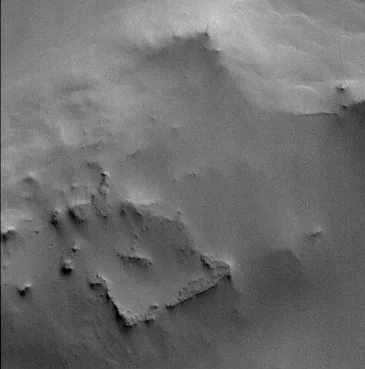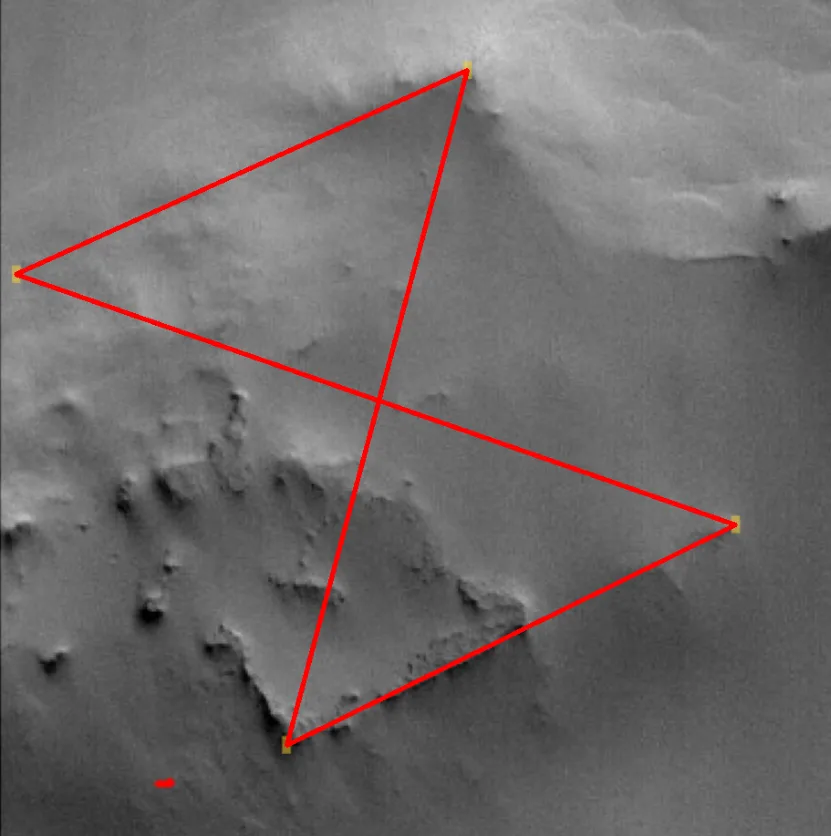Pyramid on Mars

The discovery of a pyramid-like structure has sparked significant interest due to its striking geometric features and mathematical precision. When analyzed, the structure reveals dimensions and proportions that mirror, and in some cases surpass, Earth’s most iconic pyramids, such as the Great Pyramid of Giza. Measuring approximately 5.06 km per side, this Martian formation is nearly 22 times larger than its Egyptian counterpart, with its design encoding constants like π and Φ. This raises critical questions about its origin. Supporting this analysis is a declassified CIA remote viewing session from 1984, which describes similar pyramid-like structures on Mars, suggesting a possible connection to a lost civilization.
The analysis of the Mars pyramid-like structure in image E1000462 from the Mars Global Surveyor MOC reveals striking similarities to known pyramids on Earth, particularly the Great Pyramid of Giza. By utilizing the provided pixel scale of 6 meters per pixel, the estimated side length of the Mars structure is approximately 5,059.50 meters (5.06 km). This makes it about 21.96 times larger than the Great Pyramid of Giza, whose base measures 230.4 meters. The sheer scale of this potential pyramid raises important questions—if artificial, it would be among the largest known structures in the solar system. Its square base is consistent with Earth pyramids, but its size is unprecedented, suggesting an advanced construction effort.

Beyond its size, the Mars pyramid also appears to encode mathematical and cosmological relationships, much like the Great Pyramid of Giza. When applying the same mathematical principles, the estimated height of the Mars pyramid, assuming a proportional design, would be around 3.22 km. The perimeter of the structure, 20,238 meters, when divided by twice its height, gives a value of 3.145, which is remarkably close to π. This strongly suggests that if the structure was designed rather than naturally formed, as it follows the same mathematical precision as pyramids on Earth.
Recent image analysis shows a red-outlined square within the Mars structure, aligned with key yellow markers that highlight its edges. This geometric overlay indicates that the structure follows a precise, intentional layout rather than a random formation. The square, when measured, shows consistency with π (3.1416) and Φ (1.618) proportions, reinforcing that this is an engineered structure. The symmetry and alignment of the square also suggest that the design may have been guided by advanced mathematical principles.
Another independent analysis of image E1000462 suggested that the square-like structure has sides measuring approximately 3 km. However, our measurement, based on the NASA-documented pixel scale of 6 meters per pixel, results in a side length of 5.06 km. This discrepancy may stem from differences in measurement methods, with our analysis relying on precise pixel calculations and proportional verification using π and Φ. The alignment of the square with these mathematical principles supports the accuracy of the larger measurement.
Further, while the Great Pyramid’s height is 1/43,200th of Earth’s polar radius and its perimeter corresponds to 1/43,200th of Earth’s equatorial circumference, the Mars pyramid does not fit this same proportional model. When applying the proportional model to the Mars pyramid, its estimated height of 3.22 km, multiplied by 43,200, results in 139,104 km. This is significantly larger than five times Mars’ equatorial circumference (21,344 km × 5 = 106,720 km), creating a discrepancy of over 32,000 km. This suggests that the Mars pyramid might follow an entirely different mathematical system. Mars has unique planetary parameters, such as a solar day (sol) lasting approximately 24.6 hours and a year spanning 687 Earth days. Additionally, Mars experiences axial precession over a period of about 125,000 Earth years, much longer than Earth’s 25,765-year cycle. These unique temporal and spatial metrics could have influenced the design of the pyramid-like structure, suggesting that its dimensions and orientation might encode knowledge of Mars’ celestial mechanics.
In addition to the analysis of the pyramid, a declassified CIA document titled MARS EXPLORATION, MAY 22, 1984, adds an intriguing layer to the discussion. The document details a remote viewing session where the viewer describes large, pyramid-like structures on Mars, consistent with the features observed in image E1000462 from the Mars Global Surveyor. The remote viewer, under controlled conditions, identified these formations as ancient, weathered pyramids, suggesting their origins date back to a time when Mars had a more hospitable environment. This corroborates the notion that the structures might not be random geological formations but remnants of a lost civilization.
The viewer further described the pyramids as being associated with tall, thin humanoid beings who were in the process of facing catastrophic environmental changes. These beings were said to be engineers or architects of the structures, built to align with planetary and possibly even interplanetary phenomena. This aligns with the mathematical and cosmological precision identified in the Mars pyramid’s dimensions and supports the hypothesis that the structure may encode celestial mechanics specific to Mars.
The document also highlights the viewer’s perception of subterranean chambers beneath the pyramids, which could potentially contain artifacts or further evidence of advanced engineering. This adds a new dimension to the current understanding of the Mars pyramid, suggesting that not only its external features but also its internal structure may hold keys to unraveling its origins. The combination of remote viewing data and physical measurements strengthens the argument for the artificiality of the pyramid-like structure on Mars, pushing the boundaries of what we know about ancient civilizations beyond Earth.
The Mars pyramid-like structure challenges conventional assumptions about the planet’s geological history. Its scale, geometric precision, and mathematical correlations point to intentional design rather than random natural formation. Remote viewing accounts describing ancient architects and subterranean chambers further support the possibility that this is an engineered structure.

